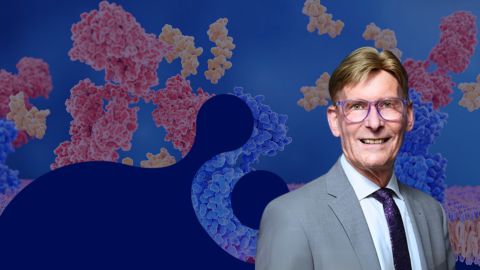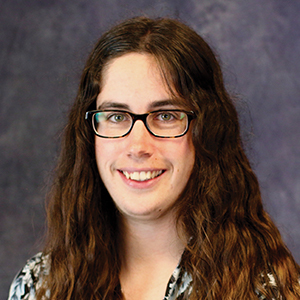JBC Tabor award: Calculating the protein—evolution connection
Sandeep Eswarappa has devised mathematical models to explain what drove this fusion event.
Growing up in Kadur, a small town in India, Eswarappa became interested in research while observing experiments in his father’s high school science laboratory. After earning an M.B.B.S. degree (equivalent to an American M.D.), he pursued a Ph.D. at the Indian Institute of Science, or IISc, studying host-pathogen interactions in Salmonella.
 Sandeep Eswarappa uses mathematical models to study a fusion of two genes in single-celled ancestors of modern animals. Genetic rearrangements, duplications and fusions have occurred throughout the evolution of life on Earth. In an ancient single-celled ancestor to modern animals, a fusion occurred between two enzymes responsible for adding amino acids to growing protein chains.
Sandeep Eswarappa uses mathematical models to study a fusion of two genes in single-celled ancestors of modern animals. Genetic rearrangements, duplications and fusions have occurred throughout the evolution of life on Earth. In an ancient single-celled ancestor to modern animals, a fusion occurred between two enzymes responsible for adding amino acids to growing protein chains.
“During this time I was exposed to the vibrant intellectual environment of IISc and developed interests in theoretical biology, evolutionary biology and genomics,” he said.
After earning his Ph.D., Eswarappa moved to the Cleveland Clinic Lerner Research Institute for postdoctoral work in the laboratory of Paul Fox. While his research focused on the formation and repair of blood vessels in the heart, Eswarappa also was fascinated by the connection between changes in protein production and animal evolution.
Because the earliest unicellular ancestors of modern animals lived about 1 billion years ago, Eswarappa and colleagues needed to develop equations to study them.
“The main challenge was to express a purely biological concept in mathematical terms,” he said.
Eswarappa’s models suggest that changes in metabolism provided an evolutionary advantage for the fusion of the two enzymes studied in the Fox lab.
Outside of the lab, Eswarappa keeps his focus on science. He enjoys watching Carl Sagan or David Attenborough documentaries and reading books by Richard Dawkins or Simon Singh.
In 2015, Eswarappa moved back to the IISc to start his own laboratory as an assistant professor; there, he continues to study the regulation of protein production and blood vessel formation.
Protein fusion drives animal evolution
Single-celled ancestors of modern animals lived about 1 billion years ago, when atmospheric oxygen was at less than 1 percent of modern levels. The lack of oxygen slowed the reactions that produce the amino acid proline and its precursor, glutamic acid, from intermediates in the breakdown of carbon-rich molecules to produce energy.
These organisms began incorporating more proline into their proteins, which later would support multicellularity. This further depleted cellular stores of proline, impairing the ability of ancient organisms to produce proteins.
Sandeep Eswarappa and his colleagues suspected that these changes drove the fusion of two genes responsible for incorporating proline and glutamic acid into proteins. To test this hypothesis, they used a series of equations to model the response of organisms with and without the fusion to changes in the supply and demand of proline. Organisms with fused genes responded much better, likely because the fusion connected proline usage to the supplies of molecules needed to produce it.
For the paper reporting this research, Eswarappa received a 2019 Journal of Biological Chemistry/Herbert Tabor Young Investigator Award.
“Our work provides compelling evidence for the close evolutionary relationship between two fundamental processes of life — protein synthesis and the central carbon metabolism,” Eswarappa said.
In the future, the group plans to look for other genetic fusion events that facilitated the evolution of animals.
Enjoy reading ASBMB Today?
Become a member to receive the print edition four times a year and the digital edition monthly.
Learn moreGet the latest from ASBMB Today
Enter your email address, and we’ll send you a weekly email with recent articles, interviews and more.
Latest in People
People highlights or most popular articles

Sketching, scribbling and scicomm
Graduate student Ari Paiz describes how her love of science and art blend to make her an effective science communicator.

Embrace your neurodivergence and flourish in college
This guide offers practical advice on setting yourself up for success — learn how to leverage campus resources, work with professors and embrace your strengths.

Survival tools for a neurodivergent brain in academia
Working in academia is hard, and being neurodivergent makes it harder. Here are a few tools that may help, from a Ph.D. student with ADHD.

Quieting the static: Building inclusive STEM classrooms
Christin Monroe, an assistant professor of chemistry at Landmark College, offers practical tips to help educators make their classrooms more accessible to neurodivergent scientists.

Hidden strengths of an autistic scientist
Navigating the world of scientific research as an autistic scientist comes with unique challenges —microaggressions, communication hurdles and the constant pressure to conform to social norms, postbaccalaureate student Taylor Stolberg writes.

Richard Silverman to speak at ASBMB 2025
Richard Silverman and Melissa Moore are the featured speakers at the ASBMB annual meeting to be held April 12-15 in Chicago.

